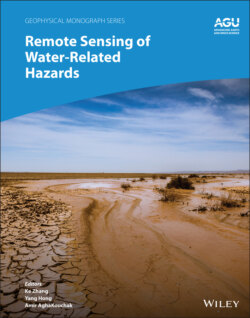Читать книгу Remote Sensing of Water-Related Hazards - Группа авторов - Страница 23
2.1. INTRODUCTION
ОглавлениеPrecipitation is an indispensable element of global water and energy cycles (Trenberth et al., 2003). As an important source of land water resources, precipitation has a direct link with human society. Extreme precipitation can often trigger natural hazards such as floods and landslides (Hong et al., 2007; Zeng et al., 2017; Vionnet et al., 2019). More frequent and severe extreme precipitation is observed or predicted due to the warming global climate. Therefore, extensive research has been conducted on the occurrence/quantity estimation and temporal and spatial changes of precipitation (Hong et al., 2006; Yong et al., 2013; Behrangi et al., 2018; Hong et al., 2018).
There are various ways of measuring precipitation, such as rain gauges, weather radars, ocean buoys, and satellite sensors. Rain gauges provide the most reliable point‐scale measurements but suffer from problems such as limited spatial coverage, point‐area mismatch, and measurement errors (Legates & Willmott, 1990; Yang et al., 2005). Satellite remote sensing is the only practical method to obtain global rainfall and snowfall, whereas the other methods can hardly achieve global coverage even if they may be more accurate on a point or regional scale. The Tropical Rainfall Measurement Mission (TRMM) and Global Precipitation Measurement (GPM) are two milestones in the field of satellite remote sensing of precipitation. Many popular precipitation products are developed in recent years, such as the Integrated Multi‐satellitE Retrievals for GPM (IMERG; Huffman et al., 2019), the TRMM Multisatellite Precipitation Analysis (TMPA; Huffman et al., 2007), Climate Prediction Center (CPC) MORPHing technology (CMORPH; Joyce et al., 2004), and Precipitation Estimation from Remotely Sensed Imagery Using Artificial Neural Networks (PERSIANN) Cloud Classification System (PERSIANN‐CCS; Hong et al., 2004).
Particularly, the IMERG products (0.1° and 30 minutes), which are built on the advances of many previous satellite precipitation algorithms, have gained strong appeals to the community since its release in April 2014. Many studies show that IMERG is superior to other precipitation datasets in many cases (Tang, Ma, et al., 2016; Tang, Zeng, et al., 2016; Jiang & Bauer‐Gottwein, 2019; Tang et al., 2020). Recently, IMERG completed the retrospective processing using the updated V06 algorithm and covers the period starting from June 2000. This reproduction process makes IMERG more suitable for long‐term hydrological and meteorological studies, such as flood simulation and monitoring (Zhang et al., 2015).
Flash floods are often triggered by intense precipitation in a short period, such as a few minutes to a few hours. Flash floods are among the most destructive natural hazards in the world and can cause huge economic losses and casualties. For example, the National Weather Service (NWS) of the USA reported that 278 people died from flash floods from October 1, 2007, to October 1, 2015 (Gourley et al., 2017). Moreover, on average, 984 people die per year due to flash floods in China since 1950 (Guo et al., 2018). Therefore, there is a strong demand for flood forecast and monitoring, particularly considering the accelerated processes of climate change and land degradation. Near‐real‐time satellite precipitation products provide new opportunities to flood monitoring. This is extremely important for alpine regions where the ground‐based measurements are usually scarce or absent. Meanwhile, it is known that satellite precipitation products could underestimate extreme precipitation due to the limitation of sensors and retrieval algorithms.
To improve the accuracy of early warning, appropriate flash flood early warning methods are one of the key factors. The current classic methods include soil moisture index (SMI), flash flood guidance (FFG), rain trigger index (RTI), etc. (Tang et al., 2017). FFG, among the most widely applied methods, was proposed by the US River Forecasting Center in the early 1970s. FFG defines precipitation that is required to generate bank‐full flood conditions related to flash floods within a given time and area (Shen et al., 2014). However, FFG has high data requirements due to the consideration of many influencing factors. SMI can accurately describe the soil moisture trend in the aeration zone, which is mainly obtained from the total water depth of a three‐layer tank model with fixed parameters; but its parameters related to the infiltration time are difficult to obtain. Taking into account the effective cumulative rainfall and rainfall intensity, the RTI method focuses on antecedent conditions and has been proved to be effective in predicting flash floods (Tang et al., 2017). However, this method is dependent on rainfall stations, lacks consideration of intermittent rainfall, and is greatly affected by rainfall field segmentation. Furthermore, since the RTI model uses the deductive coefficient of previous days to calculate the previous rainfall, this will induce a higher false alarm rate. An improved RTI method was proposed by Chen et al. (2017) to calculate the antecedent rainfall and effective accumulated rainfall, and it performed well in practical applications.
Overall, the objectives of this work are twofold: (1) evaluating the quality of existing satellite precipitation products in China with special attention paid to IMERG and (2) applying IMERG near‐real‐time data to flash flood warning in a typical region, Yunnan Province, China, based on the improved RTI method. The materials (figures and analyses) in this chapter are reorganized based on the latest research work from the authors, i.e., Tang et al. (2020) and Ma et al. (2020). The results can provide some guidance on the selection of satellite precipitation products according to their characteristics and application of the latest satellite products in flood hazards.
